I originally wanted to shoot Lacia in front of a printed sky backdrop, as I did with Charlotte Yeager some time back. Unfortunately, it looked terrible and after giving up on that idea, I did what I usually do when that happens, which is to panic and get depressed. When an idea of mine fails, I fall back on what works, backdrops that I’ve previously used that I know how to light and how they will look. For futuristic, sci-fi figures, I like to use this backdrop, which comprises an abstract, geometric design – not particularly eye-catching but I think it does a good job complementing those sorts of figures.
The background is not made of fancy materials; it’s just a couple of pieces of foam packing material with some styrofoam strips leaned up against a sheet of gray foamboard. The floor is a sheet of white foamboard covered with a sheet of transparent acrylic. Most of the interesting stuff is going to be generated by the lighting, particularly by the use of colored gels. Gels are just pieces of transparent colored plastic, and you can see that the flashgun here has a gel taped over the flash tube. Two gels, actually; one is stacked up on the other to provide a more saturated color.
The idea here is that one side of the background will be lit hard, using flashguns with no diffusion. The flashes are firing at the left side of the background, from the camera’s point of view, and are fitted with aqua-colored gels. The white foam pieces become blown out, helping to establish the backdrop’s abstract look, and the gray foamboard takes on the aqua color of the light.
The other side of the background is, for now, lit by one flash. It is fitted with two blue-colored gels and has a LumiQuest Big Bouncer attached to it, a somewhat cumbersome modifier that I got not too long ago for a really cheap price off of B&H Photo’s used store. The nice thing about it is that it’s a very big modifier relative to the size of the background and thus creates fairly soft light, which is what I want. This flash isn’t outputting as much light as the two flashes on the other side and so it doesn’t overpower the harder, aqua-colored light; instead, the blue light fills in the areas that aren’t lit.
Note that I could have done different things with this light; I could have gelled it aqua like the other lights for a more uniform appearance, I could have augmented it with another hard light to blow out the foam pieces on the right side of the background, and I could have increased its power to get more of a bluish tint across the whole backdrop. It really depends on what sort of effect I’m trying to get.
In addition, it’s important to use a lens that can sufficiently blur the background out, and that means a macro lens or some sort of close-focusing fast prime lens, or a slower lens with an extension tube or close-up filter.
Also note that I didn’t take any setup photos when I took pictures of Lacia last month, so I shot these pictures last night. Incidentally, Lacia looks a lot like Inori and man, isn’t Guilty Crown a really crummy series? Common sense would compel me to not waste any more time on the show, but I’ve never been one to pay it much attention, and I have to admit there’s something amusing about deciding who is the biggest douchebag in the cast (I actually wouldn’t pick Shu for that title). I planned on writing a post about Guilty Crown but I think I’ve changed my mind; it’d be like trash-talking a dyslexic kid in Scrabble. But anyway, what an awful show. If this is how studios treat Redjuice’s work, I hope BEATLESS never gets an anime.
Using the UltraSoft
I think everyone who enjoys photography understands that light is a very important factor in getting good pictures. It’s less important in candid photography and photojournalism, maybe, but for studio-type pictures such as this, an understanding of how to manipulate and shape light is very useful. However, you don’t see much discussion on how to control light amongst the figure photography community. My guess is that this is because light modifiers don’t offer 36 megapixels or have red rings around them. However, I have this opinion that complete noobs obsess only over cameras and lenses and more skillful photographers think about lighting – and not just types of light sources, but placement and the quality of emitted light. The type of light source doesn’t actually matter that much compared to understanding how to control light – you could do the same thing here with desk lamps with gels, snoots, and neutral density filters (you probably already have suitable neutral density filters already in the form of toilet paper).
For this setup, I used the LumiQuest UltraSoft on the key light. It looks like this:
I’ve got a velcro strap wrapped around the flash head, and the modifier attaches right to it. It’s about eight times the size of the flash head, giving fairly soft light when used to light a figure. The neat thing about it is that it’s meant to be used with the flash head tilted vertically, which sometimes makes it easier to position. That advantage is particularly important with a figure like Lacia, who is very easy to light improperly. I’ve got some pictures of her that made me cringe when I saw them pop up on the camera LCD.
The other two lights are a snooted rim light that puts a highlight along the back side of her body and an overhead light to outline her hair. I want both lights to be hard so there are no modifiers on them besides the snoot on the rim light. I’m concerned with spill on the background – it will desaturate the blue and aqua colors – but the overhead light doesn’t seem to be causing a problem in that respect, so I didn’t bother putting a snoot on it.
With all the lights fired, the background has a nice blue tone, the acrylic sheet on the floor reflects the backdrop, and the figures looks pretty good. I’ve got a good starting point for postprocessing, and the final image looks like this:
And it looks pretty good. Nothing too fancy, but the figure stands out and I think the blue color goes well with Lacia. Blue always seems to look good as a futuristic color.
Using the Mini Softbox
The LumiQuest Mini Softbox is a tiny modifier, barely larger than the flash head itself. It looks like this:
Unlike the UltraSoft, this modifier is meant to be used with the flash head facing forward, which means it sometimes takes up a bit more room. The more important difference is that because it’s smaller than the UltraSoft, it’s a harder light source. That’s not a bad thing – soft light is often thought to be “good” light and the natural assumption is that hard light must therefore be “bad” light, which isn’t correct. At any rate, the Mini Softbox is still fairly soft when used with a small subject such as an anime figure. In addition, pushed in close, light coming from the Mini Softbox falls off quickly, and that can help set the mood of a picture.
I want a darker look with more intense blues so I’ve turned off the rim and overhead lights and the background light with the Big Bounce. The result looks like this:
The light quickly falls off below her waist, and her weapon is an impressive geometric silhouette. On the negative side, one of her eyes is nearly completely black, though that also directs attention to her other eye, which is more prominent anyway. The framing is also sort of awkward with Lacia placed a little too far left and there’s a big black lump in the lower-left corner, which is the snoot on one of the background lights. Like I said, I shot these pictures quickly last night.
What would turning the overhead and rim lights on do to the picture? They make it look like this. Which do I prefer? I’m not sure. The second one has more of a futuristic look but I think I’d go with the first one, since it’s not a style I use a whole lot and I think the light falloff is more striking.
Using the Softbox III
The LumiQuest Softbox III is typically the first modifier I try out when I take pictures of a figure. It’s 9×8 inches in size and creates very soft light. How soft? Consider this: professional photographers rave about the Elinchrom Octabank. I’ve read several photographers say that using it is like cheating; you point it at your subject and you instantly get soft, beautiful light – and well you should, since it retails for over a thousand dollars (for just the modifier – no light is included). The Softbox III, on the other hand, is at the very low end of light modifiers – it’s a foldable contraption made of plastic and cardstock. However, to a 1/8 scale figure, it would look to be about the same size as a softbox 72 inches in length along its longest dimension. How wide is the Octabank? 74 inches. I wouldn’t say the Softbox III is like a cheat code – it’s a little harder to use than that, and I’ve screwed up with it more than once, and it becomes a harder light source when used with larger figures – but it’s still my go-to modifier. Here’s what it looks like:
One of the things I don’t like about the Softbox III is that the front panel is flush with the side flaps. More fully-featured (and expensive) softboxes often have a protruding rim or lip around the front panel that will cut down on the amount of light that spills off to the sides but the Softbox III lacks anything like that, and that means light spill can be a real problem when using it to light figures. To combat this, I put some velcro along the side flaps so that I can stick some flags on the sides to block light. Observant people might note that the flag attached to the Softbox III here can also be used as a flash snoot; the length of material necessary to roll around a flash head is the same as that necessary to block off one side of the Softbox III.
The larger the size of the light source relative to the subject, the softer the light, and the Softbox III is huge compared to Lacia. The coverage area is also quite large; while the Mini Softbox left one of Lacia’s eyes almost completely dark, the Softbox III gets some light onto the far side of Lacia’s face. Not quite enough for what I want, though, so I’ll use a fill card to brighten up the shadows there.
Here is the setup, showing how crowded things can get. Note the very useful can of sliced pears holding up the fill card, which is actually just an envelope, and the tan-colored “flag” blocking off light spill from the rim light. When it comes to blocking light, I’ll often just grab stuff laying around – stuff that won’t impart a noticeable color tint, that is.
And here’s the final shot. The framing is a bit awkward, since generally speaking, you should try to avoid chopping off limbs and hands and feet at the joints, but that’s hard to do with Lacia because of her pose. I don’t think it looks that bad, anyway.
A Note on Professional Products
One of the neat things about lighting modifiers is that you can build a lot of them yourself. I use a lot of home-built stuff for taking pictures, but I also use a lot of LumiQuest products, as I’ve just described. I’ve built my own softboxes before but I never got consistent exposures from them, probably because they featured front panels made of wrinkled cloth, and they were very heavy, which is a big problem for any modifier that mounts directly to the flash head. In addition, it took me at least a couple of hours to build each one; the Softbox III sells for about $30 or so, and I value my free time at a rate much greater than $15/hour. I’m very pleased with the modifiers I use and I’ve spent a lot of time figuring out what each one can do. However, this is not a suggestion that buying professional light modifiers is going to automatically improve the quality of your photos. The important thing is being able to shape the light to get the effect that you desire; the amount of money that you spend on photographic equipment doesn’t have a strong correlation on the quality of your pictures.
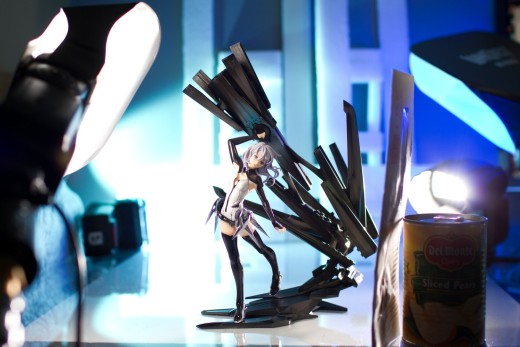
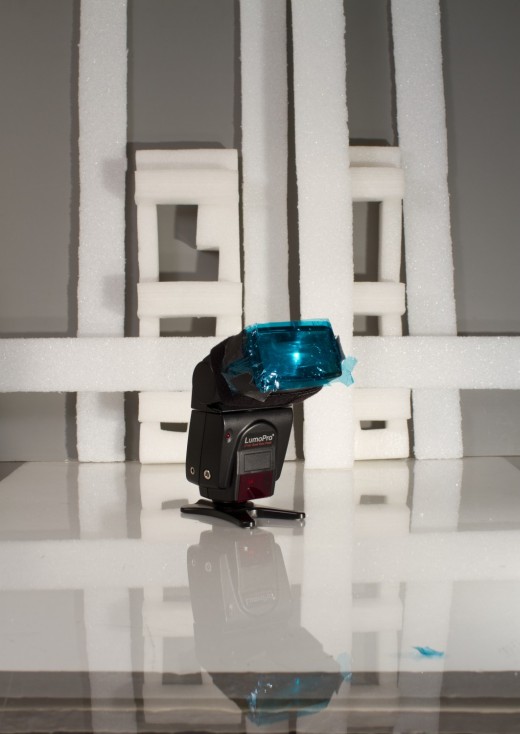
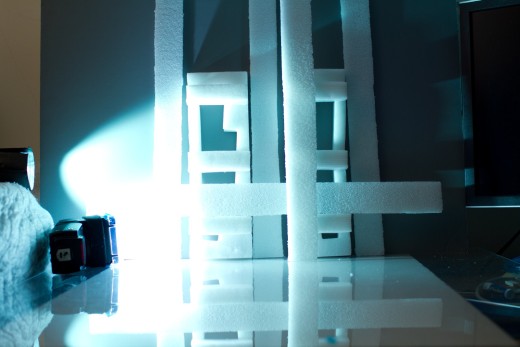
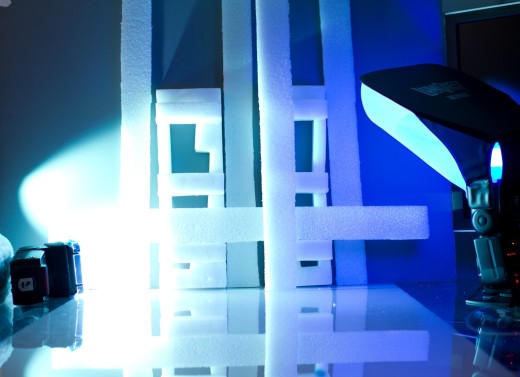
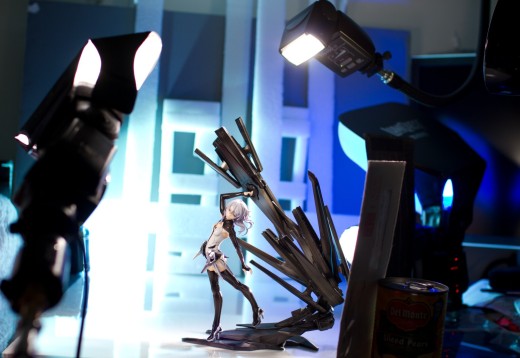
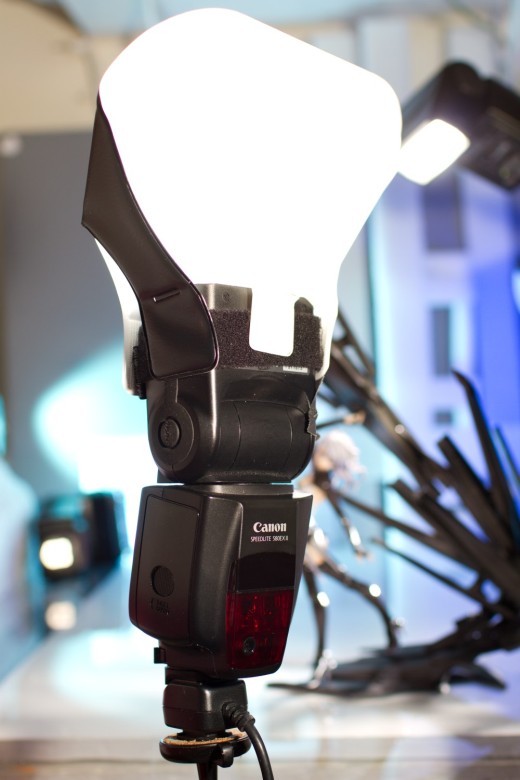
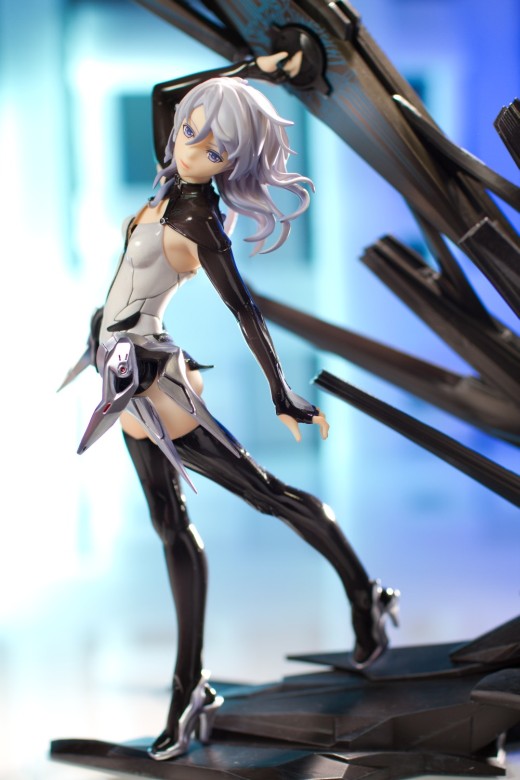
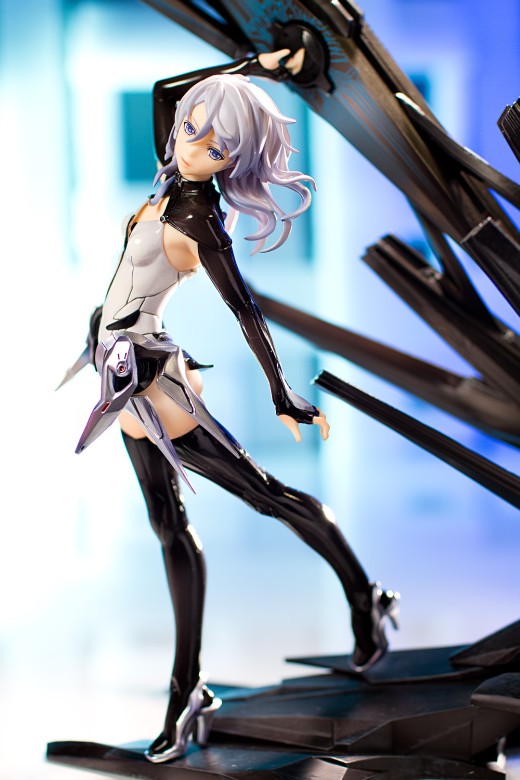
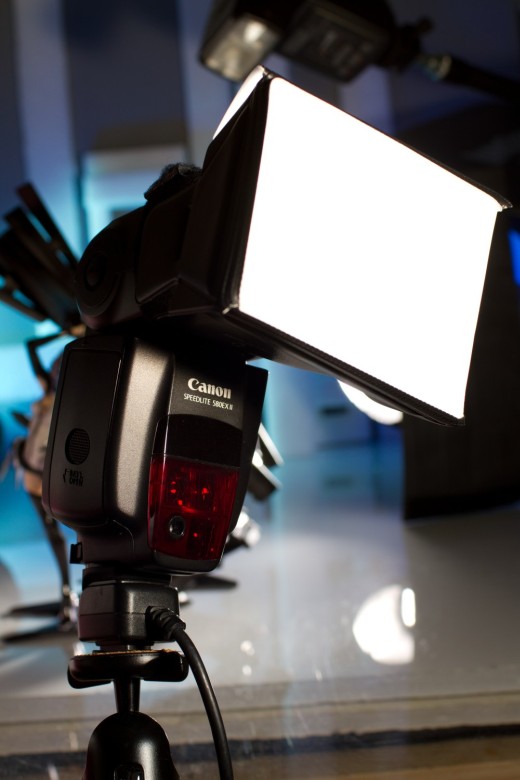
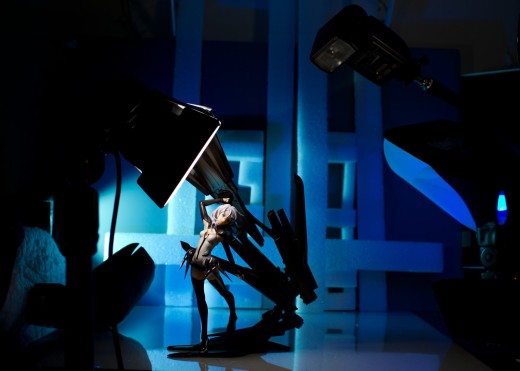
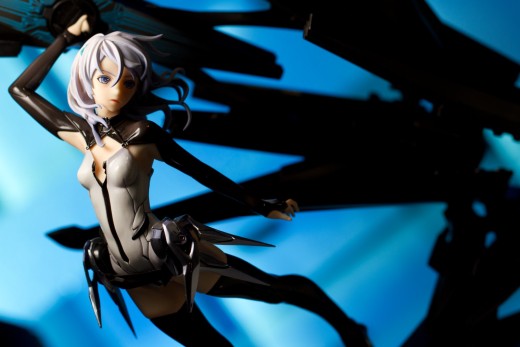
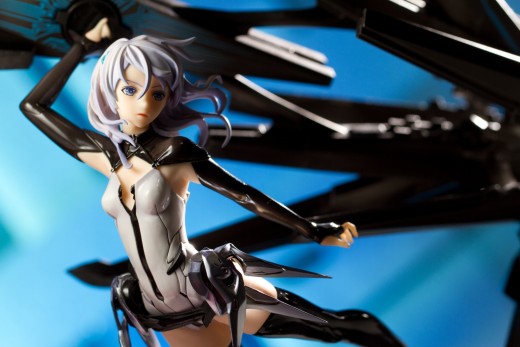
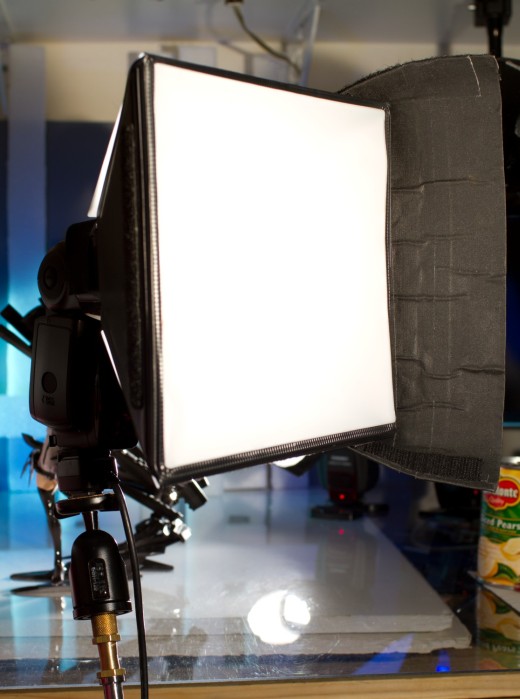
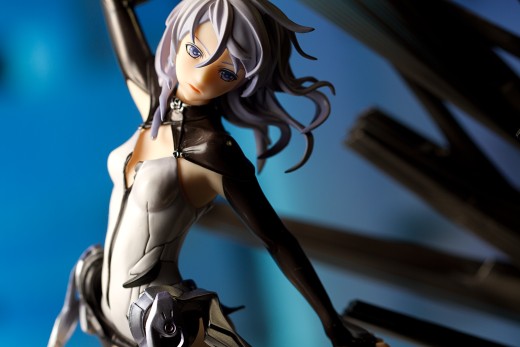
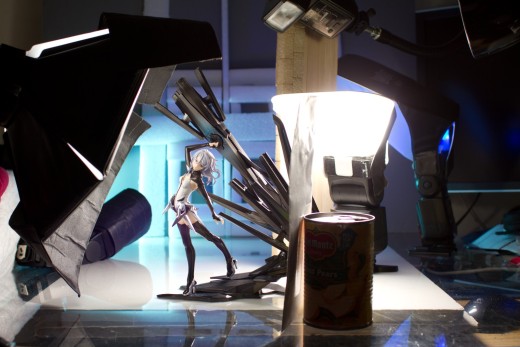
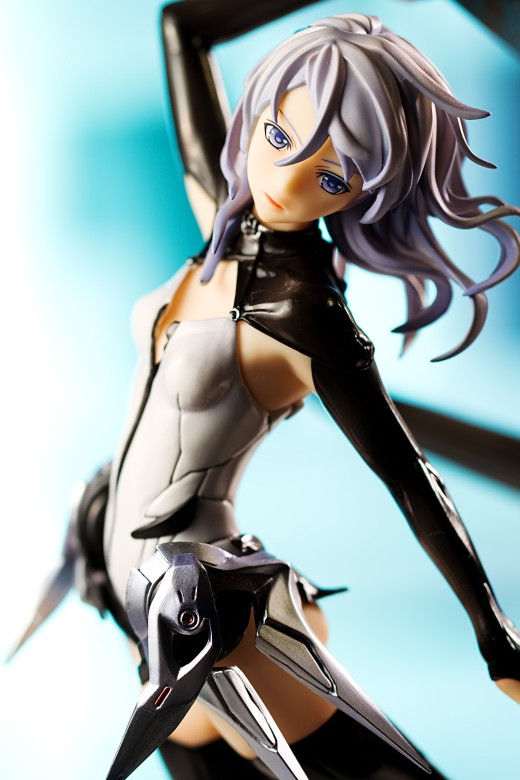











Ahh I was waiting for something like this. I’m not a strobist, but as you say, the basic principles can be extrapolated to lamps, too. And I spent as much on my lamps as a semi decent lens costs, so I don’t really want to change now; I need to learn to use them.
I’ve been considering just wrapping some cardboard (the stuff I use for backdrops, old scratched/stained pieces I can’t use as a bg any more) around to really focus the light, but I’ve been lazy about trying to do so. Plus I have no tape. I think I have a stapler somewhere, maybe I should try just stapling it in to a tube and forcing it over the light…
The idea of gels just for setting mood lighting (as opposed to tinting the figure itself, which I doubt I’d ever want) hadn’t occurred to me. I may see about picking up a pad or two. I am, however, in total agreement with you about my time being worth more than cheap products cost, so I would sooner just buy cheap modifiers than faff about with making them, especially given I’m a cripple and have limited use of my hands anyway, so making any complex modifiers (or sets) is just not gonna happen.
I’ve not looked for these sort of modifiers before, though. The flash my photography teacher gave me has a little hood on it, which I think is neat (It’s a lumiquest too, looking at it now) but it’s only for a flash unit, I couldn’t use it on my lamps; and what I want to do with one or two of my lamps is just turn it in to a spotlight, anyway. Which I may be able to do just with a roll of card, as I said.
Still, if you could provide some links to places that sell them at nice prices (ebay stores etc, cheap chinese stuff is a godsend) — I bought my flex arm+clamp from BH, and the shipping was $1 more than the arm and clamp itself. So I’m not keen on using them for cheap modifiers, unless I buy a bunch at once to make the $50-70 shipping worth it. But I need to start slowly, and preferably at low cost, so can’t go making a large order of stuff anyhow.
Your shooting space looks roughly the same size as mine; http://myfigurecollection.net/picture/351223&ref=user%3AAsako+album%3A2644 though I’ve figured a way to expand it a few inches and will be doing so once I stop being lazy. so I (probably incorrectly) assume I can do the same sort of setups you use, in a broad sense. The problem is much of it is just elbowgrease, which is something I ran out of years ago. But I still like to try to improve my photography, and won’t buy a bigger/better camera because mine “doesn’t take good photos” — I know all fault lies with me, and a lot of that is lighting.
Need more of these sorts of articles. ^^ It’s hard to find stuff specific to figures, which can have odd poses, as you say, it can be difficult to frame them “correctly” and such.
Unrelated, I did just buy a set of tubes, which should hopefully be here tomorrow. Will be fun to toy with them. I have a macro lens which lets me get in close (see http://fuyumi.minus.com/mbn9XcQghZ#1g for some recent examples of toying with it) but tubes on it, or my other lenses will be very fun to play with, if only to mess with razor thin DoF and odd perspective stuff possible. They were cheap (for K mount, which are rare these days) and will be my last photographic expense for several months at least; too many figures to pay for over the next few. 😀
Yeah, the principles of light don’t change just because you’re using LEDs or the sun instead of a flashgun; the same guidelines regarding distance, direction, quality, and intensity apply. For this sort of photography, understanding how light works is much more important than selecting a particular type of light source.
I use gels all of the time and they’re one of the most powerful tools I have, I think. Being able to color light to present different effects is incredibly useful. I’ve never used them with continuous lights but I’m sure they work fine.
Your lights look to be of similar size to flash heads so the LumiQuest or other on-flash modifiers might work, though you might need to place some adhesive-backed velcro onto your lights to keep them in place. LumiQuest’s stuff is reasonably popular, I think, so you might be able to find an Australian store that carries the brand. That said, a softbox doesn’t need to be too complicated; this sexy modifier is the one I used for almost all of my shoots up until early last year. No joke; that was my key light modifier for over a year. It actually took me a long time to warm up to the Softbox III because controlling spill was a lot easier with the USPS Priority Mail softbox. It didn’t take too long to build, too; I just cut out one end and taped white cloth over it.
I’d like to write more of this sort of thing, and I’m planning on doing so. I just need to get everything organized and coherent (which I was not when I was writing this post; I was actually half-comatose due to being ill most of this past week). It’s really unfortunate how I do all of my best writing mentally when I am trying to fall asleep and when I sit down in front of the computer to write, I find that I’ve forgotten everything that I had wanted to say.
Extension tubes sound like neat fun; I’ve actually had them on my shopping list for a very long time because I want to use my zoom lens close up to distort perspective (I think I might’ve mentioned this a while back when you were asking about wide-angle lenses, but I’ve been really wishing that there were such a thing as a wide-angle macro lens). The other thing on my shopping list is a 60mm macro lens, which may sound odd given that I already own two 100mm macro lenses.
I need to play with perspective. All of my shooting to date has just been mug shot/portrait type stuff, never really tried with creative angles or anything (closest is my earlier upskirts, but I gave up on that and just tilt figures to get angles for them now).
My tubes arrived today, and they certainly allow me to get in damn close; I can’t even use all three with my 90mm macro, because the focusing distance is inside the lens. Gets riiight in there. http://fuyumi.minus.com/mbn9XcQghZ#11 being the best example; castor sugar, the very largest of those grains is .35mm. http://fuyumi.minus.com/mbn9XcQghZ#12 <.5mm DoF. 😀 Yet to experiment with figures using them, but I'll have to think about how they may allow me to do something neat.
The problem with buying stuff here in AU is prices are unreasonably expensive for just about everything. Technology generally has some of the lowest prices (on par with US) but random photographic accessories always end up costing a fortune, which is why I buy things like hoods, filters, remotes and such from China. So many wonderful ebay stores. That's why I'd rather make a list of stuff to buy, and order a batch from BH (so shipping doesn't touch me in my nono place) or just pick up knockoffs from ebay if I can find anything decent. I guess I will have to poke around some.
Given you shoot Canon, you can get a set of tubes for like $10 or something similarly stupidcheap, though I'm not sure if they're fully manual or what as I really know nothing about other systems; the "auto" tubes I have allow for in-body aperture control and meter correctly, having contacts to detect the lens focal length and whatnot, but don't have AF screw connectors. Not like AF is useful in macro work anyway. I think Canikon have AF motors in the lenses, not bodies, so maybe AF tubes for them are cheaper to just have contacts to pass that through — as I said, I'm still struggling to learn my system, don't have time to think about others so don't really know anything. Other than the 5D II is a heavy bitch. A friend has one and let me use it a bit before I got my camera, and it was far too unwieldly for me. Helped influence my decision. 😀
Anyway. More shop talk articles. Definitely needed, when you get your head in order. I know how sickness and restlessness and such can be. Get well, jot down notes (or use a personal recorder/phone memo thing) when you think of stuff, and try to piece them together. Works for some people, anyway. I've never done voice recording stuff, so can't be cure myself. ^^;
Related: How do you feel about “lessons” like this: http://www.youtube.com/watch?v=kZr83aGHAGE I know they’re a big store and should hopefully have people who know what they’re talking about. Many many “episodes” there to dig through, but I’m watching this one atm to hopefully glean some useful info. 😀 Still curious on your opinion on such.
Perspective is something I’m trying to learn more about. In the last few months I’ve mainly used it to establish size relationships between the figure and the backdrop (i.e., like the Sasara post, I wanted the backdrop to look relatively big so I used a wider lens). I’ve also been interested in using it to intentionally distort the figure itself; back in my Amane Shiratori post, I wanted to make her butt look huge so I got as close as I could with a 35mm lens (I would’ve liked to go wider but my zoom lens can’t focus close enough). I also did that with Yukino Hongou, of all figures.
Yeah, there’s a lot of great stuff on eBay from Chinese sellers. I’ve got a bunch of flashguns, lens adapters, and cleaning cloths from Chinese sellers and I’ve been meaning to buy a hood for my zoom lens since Canon didn’t include one (even though it’s a frippin’ $750 lens). They sell a ton of stuff that caters to off-camera flash enthusiasts, including softboxes, so maybe somebody’s made a cheaper analogue to the LumiQuest products.
Yeah, I did actually get a set of tubes from a Chinese seller last summer. I’ve got some older manual-focus lenses, like a cheap 55mm Asahi Takumar lens, some other M42 mount telephoto lens, and a Canon FD 35-105mm lens, which is what I meant to use the extension tubes with. Unfortunately they don’t work well with EOS lenses, since the EF mount is electronic and you completely lose aperture control with the cheap tubes (I heard there’s some ass-backwards way to get around that; I think you hold down the DOF button to close down the aperture blades, pull the battery out of the camera to lock the blades in place, detach and mount the lens on the tube, and then put the battery back in. That sounds like a big hassle to me.). Even manual focus wide-angle lenses are pretty expensive so I’d probably be better off getting a set of Kenko tubes.
I have this thing for big cameras. I should get another 580EX II just to act as an on-camera master all the time.
Regarding the video, that was pretty good, I learned a couple things myself and it explained the basics of positioning pretty well. One thing I’d mention is that I’ve found that keeping the light level with the figure’s face works best for me. With people, light usually looks best when it’s shining down on them, since most light sources are naturally placed overhead, but figures have big solid chunky hair pieces that tend to throw shadows over the eyes if the light is placed too high. I haven’t watched too many of the AdoramaTV videos but I did watch one some time back when they compared the Canon 1D4 to the Nikon D3s (yeah, as much as I bash needless gear acquisition syndrome … what can I say, I like gear, too). I was sorta disappointed they didn’t make a definite claim as to which is better, just to see the howls of protest that would erupt from people who use equipment made by the losing company.
I still need to learn how lenses change perspective. I do have a Sigma 17-70, which is the only zoom (of three I have) that I’m relatively happy with the sharpness of. Maybe I should compare how 17 compares to 70, though I still constantly fall back to my 35 or 90 primes. I just favour the results in almost all circumstances. My kit 18-55 is utter rubbish, though I may be biased since I got it, and the 90mm macro at the same time, so using the macro prime jaded me to the kit’s results as a complete newbie, even though that SMC 18-55 is regarded as the best of all manufacturer kit zooms. I replaced it with the Sigma, anyway.
I really don’t use wide ends much, unless I’m trying to capture quite a lot and can’t simply back away from it, so I should probably look in to how it changes perspective the way you have mentioned.
I’ve bought bunches of stuff from HK/Shanghai sellers; two hoods, lens cap holders, remotes ($5 posted on ebay for one that works with Canon, Nikon and Pentax or $50 pre-postage for official Pentax branded one… yeah) and just recently a set of pens pouches since my collection has grown and most don’t come with them. Saved quite a few hundred dollars on it, so definitely worthwhile.
Yet my lamps cost me $540, which is… a hellova lot for some lights. Though they were custom made, I did a mini-blog about them a while back; http://myfigurecollection.net/blog/1992 — I do love them, and having this much light (without the heat/power draw of halogens my light tent came with) is brilliant, but I could probably have achieved similar results with a couple $10 desk lamps and some chinese softbox as you mention for far, far less in total. So I could have possibly bought a bunch of better/more useful stuff, for less cash, but these lamps have allowed me to improve quite a lot (I feel) and also notice more of my own limitations and faults, which sets me thinking about trying to solve them, so a good learning process anyhow.
Also, I’ve been told to buy some Takumar’s. They’re the holy grail of Pentax lenses, I’m told. Old M42, but given I use Pentax, I can get an M42 adapter that lets me retain full control… I think. Honestly haven’t looked in to it yet, since I’ve only just started manually focusing. I should really look in to some old manual primes.
I’ve also just noticed (using my tubes a bunch) that my 90mm macro has some dust in it, which leaves four big spots in the top left corner if I go over f/5.6. I am not pleased (I rarely shoot wide open, most of my figure shooting is f/8-11) as it’s only 7 months old. Has two year warranty, so I’ve enquired as to whether warranty will cover that. Not holding my breath though. I had noticed spots in some earlier shots but thought it was just a spec on the filter or something, went through cleaning both front and rear several times, spots still there… always in the top left corner, so I looked down the lens with my maglite and saw some dust definitely behind the front element. Gao. Expected in 20-30 year old lenses, not one that hasn’t even been in use for a year.
But, I ramble too much. On with more breakdowns or just photography articles. 😀
[snip] If this is how studios treat Redjuice’s work, I hope BEATLESS never gets an anime. [/snip]
Not related to photography (far too poor to take it up as a hobby, despite being employed unlike most my mates). But AMEN NONETHELESS.
I said I was leaning against writing that post but as I slowly catch up on Guilty Crown, I’m finding my desire to write this post to be resurgent. I haven’t ever seen an anime jump the shark so many times, and I’m only caught up to like the middle of the series. I can’t imagine how ridiculous the second half of it is going to be.
Very interesting read. I always look forward to these write-ups.
Thanks! I’m glad they are interesting, and hopefully useful to people.
Wow, I would not have guessed that was foam material creating the shapes in the Lacia background. Nice to know you can achieve that effect using a few colored lights and some shadows. I’ve been mostly relying on pre-printed patterns to create the colors and shapes in the backgrounds I use. Sometimes it works pretty well, but more often than not I come away disappointed with the results.
I’m not sure if this is the appropriate place to ask, but what do you use to trigger all your flash heads? I think I see a sync cord on the key light, but the background flashes look like they might be wireless. I’ve been using Nikon’s ghetto in-camera triggering via the pop-up flash, which works, but it’s limited to two groups of flashes and it’s kind of clunky to use at times, so I’m looking for other options.
The funny thing is that I’m thinking about moving towards using printed backdrops. I haven’t done much of it in the past, but I’ve used a printed sky backdrop a couple of times and I thought it looked pretty good (and I used it once – with Lacia, actually – and it turned out absolutely terrible). I’m curious to see if I can print stuff out and make it look good, or at least inconspicuous.
Any place here is the appropriate place to ask; my 580EX II (which is almost always the key light) is on a long sync cord (from Flash Zebra – I’ve heard it’s actually just a Yongnuo sync cord). The main reason I use a sync cord is that the flash can be controlled through the camera menu, so I can set power, zoom, curtain sync mode, etc. without having to get up (I don’t know if Nikon cameras have this capability. I’ve asked a couple of Nikon-using people and I don’t think they knew what I was talking about, so my guess is that they do not.). The other flashes are all triggered by optical slaves; I use a bunch of manual flashes that have optical triggers built-in, though my second Canon flash (a 20-year old 540EZ) does not have an optical trigger so it’s permanently parked on a hotshoe adapter with a Sonia optical trigger attached to it. I know nearly nothing about wireless flash commander usage or CLS or commander/remote power ratios and stuff, but I do know that the SB-700 (and other higher-end Nikon units, like the SB-800, -900, and -26) has an optical slave mode (called SU-4 mode) which will trigger the flash when it sees a pulse of light.
I think the relative lack of success I’ve seen with printed backdrops is probably due to the materials I’ve chosen to try, which are mostly craft fabrics with patterns that are either too busy or repeat too often within the space of the frame. I haven’t tried taking a photograph or the like and blowing it up in print like you did for the Charlotte review. I wouldn’t mind giving that route a go, but I’d need to find some candidate source material released under a permissive license and somewhere that’ll do reasonably cheap large prints.
Thanks for the feedback regarding the wireless triggers. I thought you might be using radios, but if the optical slave modes work for you then I might just pick up a couple cheap manual flashes and see how that works out. The two flashes I have are actually SB-700s. I had to re-read the manual several times to understand the different modes, but it looks like I’ve been using the AWL mode, which seems to be a subset of CLS, with the pop-up flash as the master. I haven’t tried the SU-4 mode, so I’ll give that a shot next time around. Thanks for the tip!
I went looking through Flickr for pictures; there’s an option under their search tool to look for stuff posted under a Creative Commons license. Usually this means that your own derivative stuff has to use that same license but I figure that’s not too problematic for me, since I don’t make money off my pictures and they get jacked all the time anyway, regardless of whether I might specify a CC license or a really-restrictive commercial license.
I haven’t tried radio triggers, though they seem to be extremely popular. The optical slave triggers work fine for the most part; there’s usually enough light bouncing off my walls and ceiling that they’ll fire, even if there’s something in between them and the key light. One thing I should mention is I don’t think they work too well when shooting CLS style; they typically fire on the first or second flash pulse that they see, but since flash commander units transmit a series of pulses, that usually triggers the slave flashes early.
You are quite skilled with your flashes, it’s admirable. I hope I can improve my skills with a two flash setup in the future. To be honest I hadn’t put much effort to setup my new second flash, so that it wil work with the other one, so far I just feel more comfortable with one external flash on a cable and a few lamps.
I thought you’d create the two background colors with led lamps, but you always prefer the flashes, don’t you ^^ ?
That’s pretty much how I started off, I used one flash with my desk lamps, and it took me months to get comfortable doing that. Then I added a second flash (a Holga-brand flash) which was actually a really poor product, but I didn’t know better at the time, and to trigger both flashes, I had sync cords dangling off of my camera’s hotshoe and PC sync port. I finally migrated over to the sync cord/optical slave combination I use now after maybe five or six months of experimenting with my first flash.
Yeah, I really prefer to light with flashes with desk lamps. In fact, I don’t even know if I remember how to use continuous light; I’m much more comfortable with flashes, even though I can’t see what they’re doing till they actually fire.
>> Asa
I think the main idea is that wider lenses impart more of a diagonal look to the image, whereas telephoto lenses compress perspective to make the image look more flat. Wider lenses also make objects in the background look smaller than they would if a telephoto lens were used (at a certain distance so that the subject is the same size as it is with the wider lens). This is a topic I’ve been very interested in the last few months as I’ve studied composition, and I’ve been meaning to write a post about it, since it’s much easier to explain it with pictures.
Those lights are very neat-looking. Pricy, yeah, though one of the reasons I was happy to leave desk lamps behind is because they take up so much space, and they look much more usable than having to wrestle around a desk lamp. I know I’m critical of the gear-hoarder mentality a lot of people have, but gear can be a good thing if it gets people interested in getting better.
Ouch on that Sigma lens >.< Yeah, if it's under warranty and those spots show up in photos, I'd probably send it back to get it cleaned, if I could. I usually don't freak out too much if my gear isn't in pristine condition; my 35L lens has a bunch of weird spots all over the front element. They don't show up in pictures, but if they did, I'd be really upset.
I would very much enjoy a post on composition/perspective (possibly enough on the matter to do several separate entries, really?). Having it explained in a nice visual format will certainly help, too. A lot of textual guides drone on and on and get sidetracked, and people “in to photography” usually spend more time talking about gear and bashing other people’s brand choices than actually being helpful/constructive in any manner.
I do love my lights; built in diffusers, can interchange them with coloured acrylics (or I could easily just tape gels over them) and the tripod screw; I’m very sorely tempted to get two more flex arms to replace my monopod and mini velbon, as I find the flexibility of the arms deliciously easy to work with. It’ll be my next order from BH (gonna wait til I have a half dozen odd things to make shipping worth it) though I still need to find some cheap softboxes, as even with the diffusers on these, in harsh reflections you can see individual LEDs as seen in this 100% crop: http://i.minus.com/iBSIwUtxNo9ki.jpg
Yeah, the problem with it is I do see spots; 100% crop of top-left corner http://i.minus.com/iblPr8uW7CrrCl.jpg — they appear at f/6.7 and get more and more visible as I close down. This is f/8. I didn’t hear back today but I hope the warranty people give me some response. I may end up getting the 100mm WR one, as the WR lenses are dust sealed too, not just water most people buy them for. Problem is it costs twice as much as the one I have. Uguu indeed.
Yeah, there’s probably enough there for several posts. Though I’d really recommend that anyone interested in composition just get Freeman’s “The Photographer’s Eye”. In fact, if anybody were to ask me what the one photography book I would recommend is, it’d be that one (though if the questioner were absolutely, positively dying to dive into off-camera flash lighting, I might recommend Syl Arena’s “Speedliter’s Handbook” instead). Composition can be a very murky, nebulous, rarefied, and well, subjective subject, but Freeman describes the topic’s various aspects very thoughtfully and with a mix of common-sense intuition and historical references.
Yeah, those reflections would drive me nuts if I saw something like that going on. You might be able to just toss another layer of diffusion over the lights, like tape a paper towel over them or something. The flex arm (and Magic Arm) are definitely sweet tools; I wish I’d sprung for them at the start instead of blowing a bunch of cash on various table tripods and a Gorillapod.
Ouch, yeah, that looks pretty obvious. I don’t really have any problems going with third-party equipment (as anyone can see from all the offbrand flash units I use) but I’ve heard enough about Sigma’s quality control that I roll with Canon lenses. Though I gotta admit, that upcoming Tamron 24-70 lens with stabilization looks pretty neat. I’ve kinda been thinking about replacing my 15-85mm zoom lens because it has a variable maximum aperture which I really don’t like. I wish I’d just gotten an f/2.8 zoom, like the well-regarded Tamron one. I kinda notice there’s a theme about me regretting purchases here.
I’m bad at reading. The internet has killed my attention span, if it doesn’t have lots of pretty pictures or isn’t a short video, I probably won’t bother. I readily admit my faults. I find your articles the perfect format. ^^;
I could experiment with just paper towel or several folds of toilet paper. I’ve tried tissues and they didn’t help at all. Flex arms are bloody brilliant, I just wish they were longer so I could get some real downlighting going on. I suppose I could grip an arm to a fully extended tripod, though. Or some other Macgyver solution. Just need a few more to play with.
The mini tripod I have is one I bought for like $25 when I used my P&S, I wanted to try some stable timed shots, and it extends up to about a metre or so, which is handy, but far too small/light for an SLR so it’s just for lights now. The monopod came with my light tent (tent + four backdrops + two lamps + monopod) but it has a use now with my lamps, however I still want the flexibility of the… flex arms. My Manfrotto 875 is a great tripod, but the head is far too light to handle an SLR, so I use it for its extendibility to raise lights, though as I said, perhaps a flex arm on it may go a ways.
I’m perfectly content with my Sigma 17-70, not had any issues with it, and it’s sharp enough throughout the range for me, obviously I prefer my primes, but for a cheapish zoom it’s good. They do a constant 2.8 iirc, but it costs quite a lot more than the 2.8-4. I also love my Tamron 90mm marcro, the dust spots are the only problem with it, it’s a beautiful lens otherwise. I don’t see why people condemn third party lenses, but they tend to be the same type that say use Nikkor or Zeiss glass or you’re trash. There’s always bang for buck considerations to take in to account with everything, and Sigma/Tamron make some wonderful lenses for a third or half the cost of “on-brand” stuff. There are hits and misses, but you should always research before buying anyway.
I need to find some of the dumbbells I bought when I was younger and was of the mind to get in shape (or to build beach muscles, at least). I figure I can attach a super clamp to a 25 pound dumbbell and it should stay stable, even with a flash with a big modifier hanging off a flex arm, and that’d be a lot more convenient than attaching it to furniture (currently I attach my Magic Arm to my desk’s drawers, which is a bit limiting as far as possible placements go).
I don’t really have any issues with third-party lenses but the cost savings would have to be substantial to compel me to get one over a Canon lens. The Tamron 17-50 f/2.8 lens is very compelling for the price, particularly given that it’s less than half the price of Canon’s 17-55 (albeit without stabilization and with a notably slower and much louder autofocus motor). The Sigma 50mm f/1.4 lens, however, strikes me as less of a value, being that it’s over a hundred bucks more expensive than the Canon lens and has some notorious misfocusing issues.
Pingback: Review: Yamato 1/6 Iris Hallett ~Creators’ Labo 032~ « Figyura (フィギュラ)
Pingback: Alphamax 1/6 Lorelei; Sea of Stars, Iris | Reflective Boundary